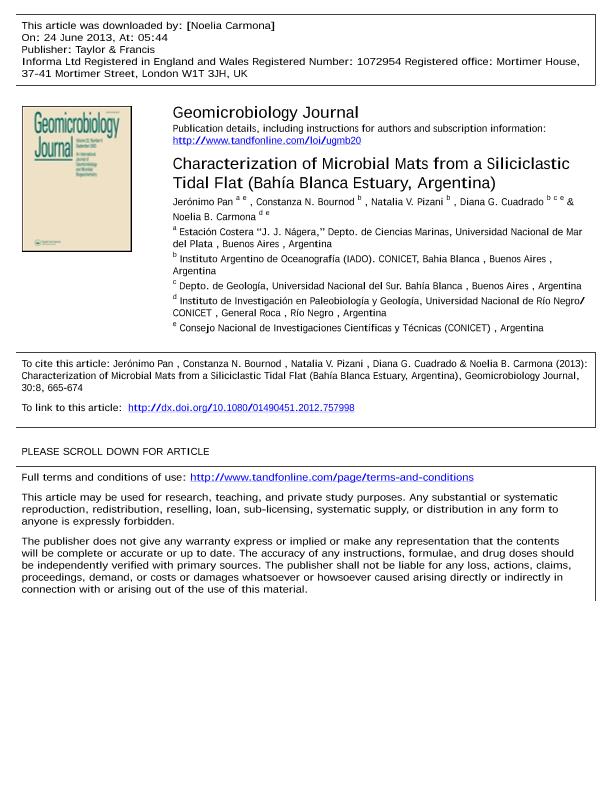Artículo
Characterization of Microbial Mats from a Siliciclastic Tidal Flat (Bahía Blanca Estuary, Argentina)
Pan, Jeronimo ; Bournod, Constanza Naimé
; Bournod, Constanza Naimé ; Pizani, Natalia Veronica; Cuadrado, Diana Graciela
; Pizani, Natalia Veronica; Cuadrado, Diana Graciela ; Carmona, Noelia Beatriz
; Carmona, Noelia Beatriz
 ; Bournod, Constanza Naimé
; Bournod, Constanza Naimé ; Pizani, Natalia Veronica; Cuadrado, Diana Graciela
; Pizani, Natalia Veronica; Cuadrado, Diana Graciela ; Carmona, Noelia Beatriz
; Carmona, Noelia Beatriz
Fecha de publicación:
18/06/2013
Editorial:
Taylor Francis
Revista:
Geomicrobiology Journal
ISSN:
0149-0451
Idioma:
Inglés
Tipo de recurso:
Artículo publicado
Clasificación temática:
Resumen
Biofilms and microbial mats cover the tidal flats of the central zone of the Bah´ıa Blanca estuary (Argentina), creating extensive layers. The objective of this study was to characterize the microphytobenthic communities in these biofilms and mats from sediment cores taken in March, June, September and December 2010. Microorganisms were identified and enumerated by microscopy, and their biomass (chlorophyll a, biovolume) quantified at two different stations in the lower supratidal zone, located ∼210 m apart from each other (namely S1 and S2). Additionally, the colloidal carbohydrates produced by these microbial communities were quantified, together with physical parameters such as temperature, granulometry, moisture and organic matter content of the sediment layers that comprise a typical epibenthic mat. On the other hand, changes in biomass and colloidal carbohydrate content were studied through a half-tidal cycle (7 h). There were significant seasonal differences in microphytobenthic biovolume (P < 0.001) with a considerably lower biomass in summer, but no significant differences in microalgal biovolume between stations (P = 0.454). Cyanobacterial biomass (largely composed of the filamentous Microcoleus chthonoplastes) was dominant on all dates at both stations, followed by pennate diatoms. Chlorophyll a and colloidal carbohydrate contents in sediment presented a similar pattern to that of microalgal biovolume; with a 5-fold variation in chlorophyll a for S1 between consecutive sampling events on September and December. There were significant differences between sampling dates in colloidal carbohydrates (P < 0.001) with the lowest values recorded during fall and winter; conversely there were no significant differences between stations (P = 0.324). Silt was the dominant sediment fraction at S1 while sand dominated throughout the uppermost 20 mm at S2. Chlorophyll a contents did not show significant differences throughout a half-tidal cycle, likely the product of vertical migration along the section sampled. Conversely, the content of colloidal carbohydrates varied 5-fold, showing a significant (P < 0.001) and steady increase with time of exposure to air and pointing to the rapid metabolic rates of the community. In conclusion, the microphytobenthic community of the Bah´ıa Blanca estuary presented marked seasonality in its biological parameters and overall physiognomy, also showing elevated metabolic rates when subject to tidal fluctuations.
Palabras clave:
Biofilms
,
Cyanobacteria
,
Diatoms
,
Microbial Mats
,
Microphytobenthos
,
Tidal Flat
Archivos asociados
Licencia
Identificadores
Colecciones
Articulos(CCT - PATAGONIA NORTE)
Articulos de CTRO.CIENTIFICO TECNOL.CONICET - PATAGONIA NORTE
Articulos de CTRO.CIENTIFICO TECNOL.CONICET - PATAGONIA NORTE
Articulos(IADO)
Articulos de INST.ARG.DE OCEANOGRAFIA (I)
Articulos de INST.ARG.DE OCEANOGRAFIA (I)
Citación
Pan, Jeronimo; Bournod, Constanza Naimé; Pizani, Natalia Veronica; Cuadrado, Diana Graciela; Carmona, Noelia Beatriz; Characterization of Microbial Mats from a Siliciclastic Tidal Flat (Bahía Blanca Estuary, Argentina); Taylor Francis; Geomicrobiology Journal; 30; 8; 18-6-2013; 665-674
Compartir
Altmétricas



